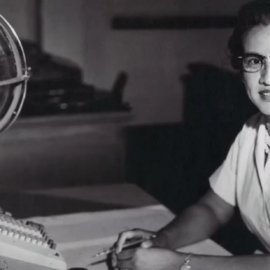

This article is an excerpt from the Shortform book guide to "Creativity, Inc." by Ed Catmull. Shortform has the world's best summaries and analyses of books you should be reading.
Like this article? Sign up for a free trial here .
Are you looking for quotes from Ed Catmull? Do you want inspiration from his book, Creativity, Inc.?
These Ed Catmull quote from Creativity, Inc. are all about the inner workings of Pixar. Learn how to make a creative workplace thrive and be inspired by Pixar’s successes.
Keep reading for three Ed Catmull quotes from Creativity, Inc.
Ed Catmull Quotes
“Failure isn’t a necessary evil. In fact, it isn’t evil at all. It is a necessary consequence of doing something new.”
The first of the Ed Catmull quotes from Creativity, Inc. is about failure. Failure is essential to a creative workplace. Without it, you can’t discover or foster new ideas because innovation requires risk. If you don’t take risks, your final product will likely be unoriginal. However, failure is hard to embrace.
As a leader, you can take the stigma out of failure by admitting your own failures. Explain what you learned from them, and how you moved forward. This will help your employees embrace and learn from their own failures.
Failure has two parts: the failure itself and how you respond to it. If you learn from your mistakes, it can help you grow and develop. Taking the time to analyze why you failed allows you to avoid similar mistakes in the future.
Knowing When to Let Go
While failure is a necessary element of creative success, consistent failure can destroy a project or organization. If a team doesn’t seem to be learning from their mistakes, you will eventually have to pull the plug on a project or remove the people who aren’t growing. If this happens, take the time to analyze why this project or person failed to learn from their mistakes. This will give you insight when it comes time to start a new project or hire a new team member. According to the first of the quotes from Ed Catmull, failure has its place. Of course, that doesn’t mean you stick to a sinking ship.
“If you give a good idea to a mediocre team, they will screw it up. If you give a mediocre idea to a brilliant team, they will either fix it or throw it away and come up with something better.”
The second of the Ed Catmull quotes from Creativity, Inc. is about the importance of a high-quality team. Disney originally wanted Toy Story 2 to be a direct-to-video sequel. At the time, this typically meant the film would be given less attention, time, and money, leading to a lower-quality product. Catmull didn’t feel comfortable creating a mediocre film, so he asked Disney to make it a full theatrical release. To his surprise, they agreed.
While Catmull was thrilled to approach Toy Story 2 as a full-fledged theatrical release, he now faced a predicament. Pixar was still working on A Bug’s Life, and, suddenly, their workload had doubled overnight. Also, most of the team who had worked on the original Toy Story were involved with the A Bug’s Life production process and couldn’t also work on Toy Story 2.
However, confident in the principles and past success of his organization, Catmull was sure that he’d be able to put together a team to work on Toy Story 2. The concept had been developed by Lasseter, and the characters and world were already established by the first film. Catmull brought on two skilled animators (and first-time directors) to lead the project. Given the fact that they had a solid concept for the film, Catmull thought Toy Story 2 would be an easy win for the studio if the team just remembered that “story is king” and to “trust the process.”
He was wrong. He brought back a lot of the team from the original Toy Story to work on fixing this project. This group was known as the Braintrust (a term which Pixar would later adopt for film review meetings), and they were known for their ability to share feedback and critique one another without defensiveness or ego getting in the way. With only nine months to complete the film (a fraction of the time most films of this nature need to be successfully produced), the team scrapped most of the existing film and started from scratch.
Catmull’s core error with Toy Story 2 was that he relied on the wrong things to ensure quality. He learned a lesson: When a mediocre team works on a great idea, the project will fail. However, when a great team works on a mediocre idea, they will either fix the idea or come up with a better one. For example, the directors of Toy Story 2 were both expert animators but mediocre directors. Though they were given an excellent concept, they failed to deliver because they lacked the proper skills to elevate the product. As seen in this example and the second of the Ed Catmull quotes, the idea is less important than who executes it.
“You’ll never stumble upon the unexpected if you stick only to the familiar.”
The third of the Ed Catmull quotes from Creativity, Inc. is about getting out of your comfort zone. Experimental projects give you a space to take risks without the pressure of making a profit. They allow your organization to explore new ideas, find better ways of working, and give employees with potential more experience. Think of these environments as a creative company’s R&D department. The nature and costs of these spaces vary from company to company, but the benefits of exploring new concepts in a safe space can yield industry-shaking results.
For example, Pixar likes to experiment by creating short films. While these projects have become a beloved and iconic part of Pixar’s releases (they show one before every feature film), these shorts aren’t meant to turn a profit. Instead, they benefit the company in the following ways:
- Team members gain experience. Because the teams working on short films are smaller than those working on feature-length films, everyone involved in the project has to be involved in multiple phases of production. This gives them a wider range of experience that helps them when they work on larger projects.
- The shorts help Pixar work through obstacles. Though most technological advancements happen on feature films, some breakthroughs were made by giving short films clear objectives. For instance, Geri’s Game, which ran before A Bug’s Life, was created with the goal of discovering a better way to animate human characters.
- If a short project fails, Pixar can move on. This allows them to put potential directors and artists in charge without risking a box office bomb. For instance, Catmull was once interested in a children’s book author who wanted to direct a feature film for Pixar. As a test, they had him helm one of their short films. The production didn’t go smoothly, and the final product was meandering and lacked an emotional spine. Because of this result, Catmull decided not to move forward on a feature led by this individual.

———End of Preview———
Like what you just read? Read the rest of the world's best book summary and analysis of Ed Catmull's "Creativity, Inc." at Shortform .
Here's what you'll find in our full Creativity, Inc. summary :
- How Pixar went from selling computers to successful animation studio
- What it takes to build a creative workplace culture
- Why George Lucas sold Pixar to Steve Jobs






